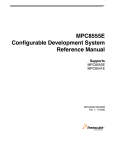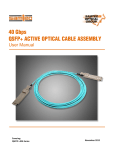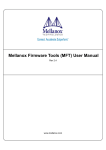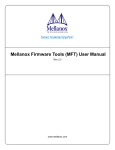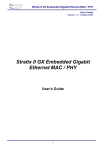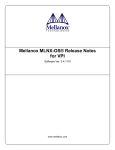Download Mellanox OFED for FreeBSD for ConnectX
Transcript
Mellanox OFED for FreeBSD for ConnectX-4
User Manual
Rev 3.0.0
www.mellanox.com
Rev 3.0.0
NOTE:
THIS HARDWARE, SOFTWARE OR TEST SUITE PRODUCT (“PRODUCT(S)”) AND ITS RELATED
DOCUMENTATION ARE PROVIDED BY MELLANOX TECHNOLOGIES “AS-IS” WITH ALL FAULTS OF ANY
KIND AND SOLELY FOR THE PURPOSE OF AIDING THE CUSTOMER IN TESTING APPLICATIONS THAT USE
THE PRODUCTS IN DESIGNATED SOLUTIONS. THE CUSTOMER'S MANUFACTURING TEST ENVIRONMENT
HAS NOT MET THE STANDARDS SET BY MELLANOX TECHNOLOGIES TO FULLY QUALIFY THE PRODUCT(S)
AND/OR THE SYSTEM USING IT. THEREFORE, MELLANOX TECHNOLOGIES CANNOT AND DOES NOT
GUARANTEE OR WARRANT THAT THE PRODUCTS WILL OPERATE WITH THE HIGHEST QUALITY. ANY
EXPRESS OR IMPLIED WARRANTIES, INCLUDING, BUT NOT LIMITED TO, THE IMPLIED WARRANTIES OF
MERCHANTABILITY, FITNESS FOR A PARTICULAR PURPOSE AND NONINFRINGEMENT ARE DISCLAIMED.
IN NO EVENT SHALL MELLANOX BE LIABLE TO CUSTOMER OR ANY THIRD PARTIES FOR ANY DIRECT,
INDIRECT, SPECIAL, EXEMPLARY, OR CONSEQUENTIAL DAMAGES OF ANY KIND (INCLUDING, BUT NOT
LIMITED TO, PAYMENT FOR PROCUREMENT OF SUBSTITUTE GOODS OR SERVICES; LOSS OF USE, DATA,
OR PROFITS; OR BUSINESS INTERRUPTION) HOWEVER CAUSED AND ON ANY THEORY OF LIABILITY,
WHETHER IN CONTRACT, STRICT LIABILITY, OR TORT (INCLUDING NEGLIGENCE OR OTHERWISE)
ARISING IN ANY WAY FROM THE USE OF THE PRODUCT(S) AND RELATED DOCUMENTATION EVEN IF
ADVISED OF THE POSSIBILITY OF SUCH DAMAGE.
Mellanox Technologies
350 Oakmead Parkway Suite 100
Sunnyvale, CA 94085
U.S.A.
www.mellanox.com
Tel: (408) 970-3400
Fax: (408) 970-3403
© Copyright 2015. Mellanox Technologies. All Rights Reserved.
Mellanox®, Mellanox logo, BridgeX®, CloudX logo, Connect-IB®, ConnectX®, CoolBox®, CORE-Direct®, GPUDirect®,
InfiniHost®, InfiniScale®, Kotura®, Kotura logo, Mellanox Federal Systems®, Mellanox Open Ethernet®, Mellanox
ScalableHPC®, Mellanox Connect Accelerate Outperform logo, Mellanox Virtual Modular Switch®, MetroDX®, MetroX®,
MLNX-OS®, Open Ethernet logo, PhyX®, SwitchX®, TestX®, The Generation of Open Ethernet logo, UFM®, Virtual
Protocol Interconnect®, Voltaire® and Voltaire logo are registered trademarks of Mellanox Technologies, Ltd.
Accelio™, CyPU™, FPGADirect™, HPC-X™, InfiniBridge™, LinkX™, Mellanox Care™, Mellanox CloudX™, Mellanox
Multi-Host™, Mellanox NEO™, Mellanox PeerDirect™, Mellanox Socket Direct™, Mellanox Spectrum™, NVMeDirect™,
StPU™, Spectrum logo, Switch-IB™, Unbreakable-Link™ are trademarks of Mellanox Technologies, Ltd.
All other trademarks are property of their respective owners.
2
Mellanox Technologies
Document Number: 2950
Rev 3.0.0
Table of Contents
Table of Contents . . . . . . . . . . . . . . . . . . . . . . . . . . . . . . . . . . . . . . . . . . . . . . . . . . . . . . . . . . 3
List of Tables . . . . . . . . . . . . . . . . . . . . . . . . . . . . . . . . . . . . . . . . . . . . . . . . . . . . . . . . . . . . . 4
Document Revision History . . . . . . . . . . . . . . . . . . . . . . . . . . . . . . . . . . . . . . . . . . . . . . . . . 5
About this Manual . . . . . . . . . . . . . . . . . . . . . . . . . . . . . . . . . . . . . . . . . . . . . . . . . . . . . . . . . 6
Chapter 1 Overview . . . . . . . . . . . . . . . . . . . . . . . . . . . . . . . . . . . . . . . . . . . . . . . . . . . . . . . 8
1.1
Mellanox OFED EN for FreeBSD Package Contents . . . . . . . . . . . . . . . . . . . . . . 8
1.1.1 Tarball Package. . . . . . . . . . . . . . . . . . . . . . . . . . . . . . . . . . . . . . . . . . . . . . . . . . . . 8
1.1.2 mlx5 driver . . . . . . . . . . . . . . . . . . . . . . . . . . . . . . . . . . . . . . . . . . . . . . . . . . . . . . . 8
Chapter 2 Installation . . . . . . . . . . . . . . . . . . . . . . . . . . . . . . . . . . . . . . . . . . . . . . . . . . . . 10
2.1
2.2
2.3
2.4
2.5
Software Dependencies . . . . . . . . . . . . . . . . . . . . . . . . . . . . . . . . . . . . . . . . . . . .
Downloading Mellanox Driver for FreeBSD . . . . . . . . . . . . . . . . . . . . . . . . . . .
Installing Mellanox Driver for FreeBSD . . . . . . . . . . . . . . . . . . . . . . . . . . . . . . .
Firmware Programming. . . . . . . . . . . . . . . . . . . . . . . . . . . . . . . . . . . . . . . . . . . .
10
10
10
11
2.4.1
2.4.2
2.4.3
2.4.4
11
12
12
12
Installing Firmware Tools . . . . . . . . . . . . . . . . . . . . . . . . . . . . . . . . . . . . . . . . . . .
Downloading Firmware . . . . . . . . . . . . . . . . . . . . . . . . . . . . . . . . . . . . . . . . . . . .
Updating Firmware Using flint . . . . . . . . . . . . . . . . . . . . . . . . . . . . . . . . . . . . . . .
Setting the Ports to ETH . . . . . . . . . . . . . . . . . . . . . . . . . . . . . . . . . . . . . . . . . . . .
Driver Usage and Configuration . . . . . . . . . . . . . . . . . . . . . . . . . . . . . . . . . . . . . 12
Chapter 3 Features Overview and Configuration . . . . . . . . . . . . . . . . . . . . . . . . . . . . . 16
3.1
3.2
Hardware Large Receive Offload (HW LRO). . . . . . . . . . . . . . . . . . . . . . . . . . . 16
EEPROM Cable Information Reader . . . . . . . . . . . . . . . . . . . . . . . . . . . . . . . . . 16
Chapter 4 Performance Tuning . . . . . . . . . . . . . . . . . . . . . . . . . . . . . . . . . . . . . . . . . . . . 18
4.1
4.2
Receive Queue Interrupt Moderation . . . . . . . . . . . . . . . . . . . . . . . . . . . . . . . . . 18
Tuning for NUMA Architecture . . . . . . . . . . . . . . . . . . . . . . . . . . . . . . . . . . . . . 18
4.2.1 Single NUMA Architecture . . . . . . . . . . . . . . . . . . . . . . . . . . . . . . . . . . . . . . . . . 18
4.2.2 Dual NUMA Architecture. . . . . . . . . . . . . . . . . . . . . . . . . . . . . . . . . . . . . . . . . . . 19
Mellanox Technologies
3
Rev 3.0.0
List of Tables
Table 1:
Table 2:
Table 3:
Document Revision History . . . . . . . . . . . . . . . . . . . . . . . . . . . . . . . . . . . . . . . . . . . . . . . . 5
Abbreviations and Acronyms . . . . . . . . . . . . . . . . . . . . . . . . . . . . . . . . . . . . . . . . . . . . . . . 7
Mellanox OFED EN for FreeBSD Software Components . . . . . . . . . . . . . . . . . . . . . . . . . 9
Mellanox Technologies
4
Rev 3.0.0
Document Revision History
Table 1 - Document Revision History
Revision
3.0.0
5
Date
November 2015
Mellanox Technologies
Description
Initial release
Rev 3.0.0
About this Manual
This Preface provides general information concerning the scope and organization of this User’s
Manual.
Intended Audience
This manual is intended for system administrators responsible for the installation, configuration,
management and maintenance of the software and hardware of VPI (Infiniband, Ethernet) in
ETH mode adapter cards.
Mellanox Technologies
6
Rev 3.0.0
Common Abbreviations and Acronyms
Table 2 - Abbreviations and Acronyms
Abbreviation /
Acronym
Whole Word / Description
B
(Capital) ‘B’ is used to indicate size in bytes or multiples of bytes (e.g., 1KB = 1024 bytes,
and 1MB = 1048576 bytes)
b
(Small) ‘b’ is used to indicate size in bits or multiples of bits (e.g., 1Kb = 1024 bits)
FW
Firmware
HCA
Host Channel Adapter
HW
Hardware
IB
InfiniBand
LSB
Least significant byte
lsb
Least significant bit
MSB
Most significant byte
msb
Most significant bit
NIC
Network Interface Card
SW
Software
VPI
Virtual Protocol Interconnect
PFC
Priority Flow Control
PR
Path Record
RDS
Reliable Datagram Sockets
RoCE
RDMA over Converged Ethernet
SL
Service Level
QoS
Quality of Service
ULP
Upper Level Protocol
VL
Virtual Lane
Support and Updates Webpage
Please visit http://www.mellanox.com > Products > Software > Ethernet Drivers > FreeBSD Drivers for downloads, FAQ, troubleshooting, future updates to this manual, etc.
7
Mellanox Technologies
Rev 3.0.0
1
Overview
This document provides information on the Mellanox EN driver for FreeBSD and instructions
for installing the driver on Mellanox ConnectX® adapter cards supporting the following uplinks
to servers:
•
ConnectX®-4
• Ethernet: 10GigE, 25GigE, 40GigE, 50GigE and 100GigE
•
ConnectX®-4 Lx
• Ethernet: 10GigE, 25GigE, 40GigE and 50GigE
The driver release introduces the following capabilities:
•
Single/Dual port
•
Number of RX queues per port - according to number of CPUs.
•
Number of TX queues per port - according to number of CPUs.
•
MSI-X or INTx
•
Hardware Tx/Rx checksum calculation
•
Large Send Offload (i.e., TCP Segmentation Offload)
•
Large Receive Offload
•
VLAN Tx/Rx acceleration (Hardware VLAN stripping/insertion)
•
ifnet statistics
1.1
Mellanox OFED EN for FreeBSD Package Contents
1.1.1
Tarball Package
Mellanox OFED EN for FreeBSD package includes the following directories:
1.1.2
•
mlx5 modules - contains the relevant Makefiles for mlx5 core and EN
•
drivers/net/mlx5/ - EN source code
•
drivex/mlx5/generated/freebsd/ - core source code
mlx5 driver
mlx5 is the low level driver implementation for the ConnectX-4/ConnectX-4 Lx adapters
designed by Mellanox Technologies.
Mellanox Technologies
8
Rev 3.0.0
Overview
1.1.2.1 Software Components
Mellanox OFED EN for FreeBSD contains the following software components:
Table 3 - Mellanox OFED EN for FreeBSD Software Components
Components
9
Description
mlx5
Acts as a library of common functions required by the ConnectX®-4/ConnectX-4
Lx adapter cards. For example: initializing the device after reset.
mlx5en
Handles Ethernet specific functions and plugs into the ifnet mid-layer.
Documentation
Release Notes, User Manual
Mellanox Technologies
Rev 3.0.0
2
Installation
This chapter describes how to install and test the Mellanox driver for FreeBSD package on a single host machine with Mellanox adapter hardware installed.
2.1
Software Dependencies
•
To install the driver software, kernel sources must be installed on the machine.
•
To load mlx5, linuxapi must be loaded as well.
• Compile and install linuxapi module under /sys/modules/linuxapi.
2.2
Downloading Mellanox Driver for FreeBSD
1. Verify that the system has a Mellanox network adapter (HCA/NIC) installed.
The following example shows a system with an installed Mellanox HCA:
mlx5_core0@ pci0:6:0:0:
class=0x020000 card=0x000815b3 chip=0x101315b3 rev=0x00 hdr=0x00
vendor
= 'Mellanox Technologies'
device
= 'MT27620 Family'
class
= network
subclass = ethernet
mlx5_core1@pci0:6:0:1:
class=0x020000 card=0x000815b3 chip=0x101315b3 rev=0x00 hdr=0x00
vendor
= 'Mellanox Technologies'
device
= 'MT27620 Family'
class
= network
subclass = ethernet
2. Download the tarball image to your host.
The image name has the format MLNX_OFED_FreeBSD-<ver>.tgz. You can download it from
http://www.mellanox.com > Products > Software > Ethernet Drivers > FreeBSD
3. Use the md5sum utility to confirm the file integrity of your tarball image.
2.3
Installing Mellanox Driver for FreeBSD
FreeBSD v3.0.0 supports adapter cards based on the Mellanox ConnectX®-4 family of adapter IC
devices only. If you have ConnectX-3 and ConnectX-3 Pro on your server, you will need to install
FreeBSD v2.1.6 driver.
For details on how to install FreeBSD v2.1.6 driver, please refer to FreeBSD v2.1.6 User Manual.
1. Extract the tarball.
2. Compile and load needed modules in the following order of dependencies:
mlx5 core
a. Go to the mlx5 directory. Run:
# cd mlx5_modules/mlx5
b. Clean any previous dependencies. Run:
# bmake -m $HEAD/share/mk SYSDIR=$HEAD/sys clean cleandepend
Mellanox Technologies
10
Rev 3.0.0
Installation
c. Compile the mlx5_core module. Run:
# bmake -m $HEAD/share/mk SYSDIR=$HEAD/sys
d. Install the mlx5_core module. Run:
# bmake -m $HEAD/share/mk SYSDIR=$HEAD/sys install
e. Load the mlx5_core module. Run:
# kldload mlx5
mlx5en
a.Go to the mlx5en directory. Run:
# cd mlx5_modules/mlx5en
b. Clean any previous dependencies. Run:
# bmake -m $HEAD/share/mk SYSDIR=$HEAD/sys clean cleandepend
c. Compile the mlx5en module. Run:
# bmake -m $HEAD/share/mk SYSDIR=$HEAD/sys
d. Install the mlx5en module. Run:
# bmake -m $HEAD/share/mk SYSDIR=$HEAD/sys install
e. Load the mlx5en module. Run:
# kldload mlx5en
To load a module on reboot, add "mlx5_load="YES"/mlx5en_load="YES" to the '/boot/
loader.conf' file (create if does not exist).
Run "kldstat" in order to verify which modules are loaded on your server.
2.4
Firmware Programming
The adapter card was shipped with the most current firmware available. This section is intended
for future firmware upgrades, and provides instructions for (1) installing Mellanox firmware
update tools (MFT), (2) downloading FW, and (3) updating adapter card firmware.
2.4.1
11
Installing Firmware Tools
Step 1.
Download the current Mellanox Firmware Tools package (MFT) from
www.mellanox.com > Products > Adapter IB/VPI SW > Firmware Tools.
The tools package to download is "MFT_SW for FreeBSD" (tarball name is mft-X.X.X.tgz).
For ConnectX®-4, you will need at least MFT-4.1.X.X.X.
Step 2.
Extract the tarball and run the installation script.
Mellanox Technologies
Rev 3.0.0
2.4.2
Downloading Firmware
1. Retrieve device's PCI slot (i.e. pci0:x:0:0). Run:
#> mst status
2. Verify your card’s PSID.
#> flint -d <pci> q
3. Download the desired firmware from the Mellanox website.
http://www.mellanox.com/page/firmware_download
2.4.3
Updating Firmware Using flint
1. Before burning a new firmware, make sure the modules are unloaded. To unload the modules,
run:
#> kldunload mlx5en
#> kldunload mlx5
2. Unzip the firmware binary file.
3. Burn the firmware on your server:
$flint -d <pci> -i <img.bin> b
4. Reboot the server.
2.4.4
Setting the Ports to ETH
If you have a VPI HCA, you will need to set the ports to ETH. This is done by using the mlxconfig tool (part of the MFT).
1. If you have a card with two ports, run:
#> mlxconfig -d <pci> set LINK_TYPE_P1=2 (For the first port)
#> mlxconfig -d <pci> set LINK_TYPE_P2=2 (For the second port)
2. Reboot the server.
2.5
Driver Usage and Configuration
Interface name has changed from mlx5en to mce. Note that ifconfig and sysctl commands
were updated accordingly.
To assign an IP address to the interface:
#> ifconfig mce<x> <ip>
Note: <x> is the OS assigned interface number
To check driver and device information:
#> pciconf -lv | grep mlx
#> flint -d pci<w:x:y:z> q
#> flint -d pci0:6:0:0 dc | grep Description
Mellanox Technologies
12
Rev 3.0.0
Installation
Example:
#> pciconf -lv | grep mlx -C 3
mlx5_core0@pci0:33:0:0:
class=0x020000 card=0x001415b3 chip=0x101315b3 rev=0x00 hdr=0x00
vendor
= 'Mellanox Technologies'
device
= 'MT27620 Family'
class
= network
subclass = ethernet
mlx5_core1@pci0:33:0:1:
class=0x020000 card=0x001415b3 chip=0x101315b3 rev=0x00 hdr=0x00
vendor
= 'Mellanox Technologies'
device
= 'MT27620 Family'
class
= network
#> flint -d pci0:33:0:0: q
Image type:
FS3
FW Version:
12.12.0610
FW Release Date: 3.9.2015
Description:
UID
GuidsNumber
Base GUID:
e41d2d03006094ec
20
Base MAC:
0000e41d2d6094ec
20
Image VSD:
Device VSD:
PSID:
MT_2190110032
#> flint -d pci0:6:0:0 dc | grep Description
;;Description = ConnectX-4 VPI adapter card; EDR IB (100Gb/s) and 100GbE; dual-port QSFP28;
PCIe3.0 x16; ROHS R6
To check driver version:
#>sysctl -a
Example:
sysctl -a | grep Mellanox
dev.mlx5_core.1.%desc: Mellanox Ethernet driver (3.0.0-RC2)
dev.mlx5_core.0.%desc: Mellanox Ethernet driver (3.0.0-RC2)
To check firmware version:
• dmesg
#> dmesg
Example:
Mlx5_core0: INFO: firmware version: 12.12.2008
• sysctl
#> sysctl -a
Example:
dev.mlx5_core.0.hw.fw_version: 12.12.2008
To query stateless offload status:
#> ifconfig mce<x>
Note: <x> is the OS assigned interface number
To set stateless offload status:
#> ifconfig mce<x> [rxcsum|-rxcsum] [txcsum|-txcsum] [tso|-tso] [lro|-lro]
Note: <x> is the OS assigned interface number
13
Mellanox Technologies
Rev 3.0.0
To query and set interrupt coalescing modes:
#> sysctl -a | grep coalesce_mode
Example:
#> sysctl -a | grep coalesce_mode
dev.mce.0.conf.rx_coalesce_mode: 1
dev.mce.1.conf.rx_coalesce_mode: 1
•
coalesce mode '0' indicates interrupt timer is resetting with each interrupt event.
•
coalesce mode '1' indicates interrupt timer is resetting with each received packet.
To query and modify values for timer initialization between interrupts:
#> sysctl -a | grep tx_coalesce_usecs
#> sysctl -a | grep rx_coalesce_usecs
To query and modify values for number of received packets between interrupts:
#> sysctl -a | grep tx_coalesce_pkts
#> sysctl -a | grep rx_coalesce_pkts
Example:
#> sysctl -a | grep rx_coalesce_usecs
dev.mce.1.conf.rx_coalesce_usecs: 3
dev.mce.0.conf.rx_coalesce_usecs: 3
#> sysctl -a | grep rx_coalesce_pkts
dev.mce.1.conf.rx_coalesce_pkts: 32
dev.mce.0.conf.rx_coalesce_pkts: 32
To query ring size values:
#> sysctl -a | grep mce| grep _size
Example:
#> sysctl -a | grep mlx | grep _size
dev.mce.1.conf.rx_queue_size: 1024
dev.mce.1.conf.tx_queue_size: 1024
dev.mce.1.conf.rx_queue_size_max: 8192
dev.mce.1.conf.tx_queue_size_max: 8192
To modify rings size:
#> sysctl dev.mce.0.conf.rx_queue_size=[N]
#> sysctl dev.mce.0.conf.tx_queue_size=[N]
Note: <x> is the OS assigned interface number
To obtain device statistics:
#> sysctl -a | grep mce | grep stat
To obtain additional device statistics:
#> sysctl dev.mce.0.conf.debug_stats=1
#> sysctl -a | grep mce | grep stats
To show out of receive buffers counter:
#> sysctl -a | grep out_of_rx_buffer
dev.mce.1.pstats.out_of_rx_buffer: 0
dev.mce.0.pstats.out_of_rx_buffer: 0
Mellanox Technologies
14
Rev 3.0.0
Installation
To verify support for Rx/Tx pause frames:
• ifconfig
#> ifconfig
media: Ethernet autoselect (100GBase-CR4 <full-duplex,rxpause,txpause>)
• sysctl
#> sysctl dev.mce.0.conf.rx_pauseframe_control
dev.mce.0.conf.rx_pauseframe_control: 1
#> sysctl dev.mce.0.conf.tx_pauseframe_control
dev.mce.0.conf.tx_pauseframe_control: 1
To enable/disable Rx/Tx pause frames:
sysctl dev.mce.0.conf.rx_pauseframe_control=1
sysctl dev.mce.0.conf.tx_pauseframe_control=1
Note: 0 = disable, 1 = enable
To show all supported media:
#> ifconfig -m mce<x>
supported media:
media autoselect
media 50GBase-CR2 mediaopt full-duplex
media 25GBase-SR mediaopt full-duplex
media 25GBase-CR mediaopt full-duplex
media 100GBase-LR4 mediaopt full-duplex
media 100GBase-SR4 mediaopt full-duplex
media 100GBase-CR4 mediaopt full-duplex
media 40Gbase-LR4 mediaopt full-duplex
Note: <x> is the OS assigned interface number
The list of supported media is different in ConnectX-4 and ConnectX-4 Lx.
To set new media:
#> ifconfig -m mce<x> media <y> mediaopt full-duplex
Note: <x> is the OS assigned interface number. <y> is the relevant media
When updating the media, make sure to choose the right cable type.
Once the driver is loaded, both ports will be activated, meaning that an ifnet will be created for each
port.
15
Mellanox Technologies
Rev 3.0.0
3
Features Overview and Configuration
3.1
Hardware Large Receive Offload (HW LRO)
HW LRO is supported in ConnectX®-4 only.
Large Receive Offload (LRO) increases inbound throughput of high-bandwidth network connections by reducing CPU overhead. It works by aggregating multiple incoming packets from a single stream into a larger buffer before they are passed higher up the networking stack, thus
reducing the number of packets that have to be processed.
In order to turn on the LRO device, run:
#> ifconfig mce<x> lro
In order to turn off the LRO device, run:
#> ifconfig mce<x> -lro
When the LRO device is on, HW LRO can be turned on. HW LRO is off by default.
In order to turn on HW LRO run:
#> sysctl dev.mce.0.conf.hw_lro=1
In order to turn off HW LRO run:
#> sysctl dev.mce.0.conf.hw_lro=0
3.2
EEPROM Cable Information Reader
EEPROM is supported in ConnectX®-4 only.
EEPROM cable reading feature allows reading important information about the plugged cable,
such as cable type, cable speed, vendor and more.
In order to read the cable EEPROM info:
1. Read the cable information by enabling the following sysctl parameter. Output will be printed
in dmesg:
#> sysctl dev.mce.<X>.conf.eeprom_info:=1
Example:
#>sysctl dev.mce.1.conf.eeprom_info=1
dev.mce.1.conf.eeprom_info: 0 -> 0
#>dmesg -s
Offset
------
Values
------
Mellanox Technologies
16
Rev 3.0.0
Features Overview and Configuration
0x0000
0x0010
0x0020
0x0030
0x0040
0x0050
0x0060
0x0070
0x0080
0x0090
0x00a0
0x00b0
0x00c0
0x00d0
0x00e0
0x00f0
0d
00
00
00
00
00
00
00
0d
00
20
45
0b
34
31
00
05
00
00
00
00
00
00
00
00
00
20
30
00
20
32
00
06
00
00
00
00
00
00
00
23
01
20
30
00
20
38
00
00
00
00
00
00
00
00
00
88
a0
20
41
00
20
38
00
00
00
00
00
00
00
00
00
00
4d
1f
20
4d
31
35
00
00
00
00
00
00
00
00
00
00
65
00
20
54
35
35
00
00
00
00
00
00
00
00
00
00
6c
02
20
31
30
32
00
00
00
00
00
00
00
00
00
00
6c
c9
20
35
35
33
00
00
00
00
00
00
00
00
00
00
61
4d
41
32
32
38
00
00
00
00
00
00
00
00
00
00
6e
43
32
31
36
44
00
00
00
00
00
00
00
00
00
00
6f
50
02
56
20
33
00
00
00
00
00
00
00
00
00
00
78
31
03
53
20
33
00
00
00
00
00
00
00
01
00
ff
20
36
04
30
00
00
00
00
00
00
00
00
00
00
00
00
20
30
07
36
00
00
30
00
00
00
00
00
00
04
00
00
20
30
00
34
67
00
00
00
00
00
00
00
00
00
00
00
20
2d
3f
38
5e
00
00
2. Another option for reading cable information is by using the ifconfig:
#>ifconfig -v mce<X>
#>ifconfig -vv mce<X>
#>ifconfig -vvv mce<X>
Example:
#> ifconfig -vvv mce1
plugged: QSFP+ 40GBASE-CR4 (No separate connector)
vendor: Mellanox PN: MCP1600-E00A SN: MT1521VS06484 DATE: 2015-05-26
compliance level: SFF-8636 rev <=1.5
nominal bitrate: 25750 Mbps
SFF8436 DUMP (0xA0 128..255 range):
0D 00 23 88 00 00 00 00 00 00 00 00
00 00 01 A0 4D 65 6C 6C 61 6E 6F 78
20 20 20 20 1F 00 02 C9 4D 43 50 31
45 30 30 41 20 20 20 20 41 32 02 03
0B 00 00 00 4D 54 31 35 32 31 56 53
34 20 20 20 31 35 30 35 32 36 20 20
31 32 38 38 35 35 32 33 38 44 33 33
00 00 00 00 00 00 00 00 00 00 00 00
SFF8436 DUMP (0xA0 0..81 range):
0D 05 06 00 00 00 00 00 00 00 00
00 00 00 00 00 00 00 00 00 00 00
00 00 00 00 00 00 00 00 00 00 00
00 00 00 00 00 00 00 00 00 00 00
00 00 00 00 00 00 00 00 00 00 00
00 00
17
Mellanox Technologies
00
00
00
00
00
FF
20
36
04
30
00
00
00
00
20
30
07
36
00
00
30
00
20
30
00
34
67
00
00
00
20
2D
3F
38
5E
00
00
00
00
00
00
00
00
00
00
00
00
00
00
00
00
00
00
00
00
00
00
Rev 3.0.0
4
Performance Tuning
In order to improve performance, please make sure the HW LRO is enabled.
4.1
Receive Queue Interrupt Moderation
An armed CQ will generate an event when either of the following conditions is met:
•
The number of completions generated since the one which trigged the last event generation reached a set in advance number.
•
The timer has expired and an event is pending.
The timer can be set to be restarted either upon event generation or upon completion generation.
Setting the timer to be restarted upon completion generation affects the interrupt receiving rate.
When receiving a burst of incoming packets, the timer will not reach its limit, therefore, the interrupt rate will be associated to the size of the packets.
In order to modify the timer restart mode, run:
#> sysctl dev.mce.1.conf.rx_coalesce_mode=[0/1]
0: For timer restart upon event generation.
1: For timer restart upon completion generation.
In order to modify the number of completions generated between interrupts, run:
#> sysctl dev.mce.1.conf.rx_coalesce_pkts=<x>
In order to modify the time for the timer to finish, run:
#> sysctl dev.mce.1.conf.rx_coalesce_usecs=<x>
Note: The default values are:
•
dev.mce.1.conf.rx_coalesce_mode: 1 - Timer restarts upon completion generation.
•
dev.mce.1.conf.rx_coalesce_pkts: 32 - 32 completions generate interrupts.
•
dev.mce.1.conf.rx_coalesce_usecs: 3 - Timer count down 3 micro sec.
4.2
Tuning for NUMA Architecture
4.2.1
Single NUMA Architecture
When using a server with single NUMA, no tuning is required. Also, make sure to avoid using
core number 0 for interrupts and applications.
1. Find a CPU list:
#> sysctl -a | grep "group level=\"2\"" -A 1
<group level="2" cache-level="2">
<cpu count="12" mask="fff">0, 1, 2, 3, 4, 5, 6, 7, 8, 9, 10, 11</cpu>
2. Tune Mellanox NICs to work on desirable cores
Mellanox Technologies
18
Rev 3.0.0
Performance Tuning
a.Find the device that matches the interface:
#> sysctl -a | grep mce | grep mlx
dev.mce.1.conf.device_name: mlx5_core1
dev.mce.0.conf.device_name: mlx5_core0
b. Find the device interrupts.
vmstat -ia | grep mlx5_core0 | awk '{print $1}' | sed s/irq// | sed s/://
269
270
271
…
c. Bind each interrupt to a desirable core.
cpuset -x 269 -l 1
cpuset -x 270 -l 2
cpuset -x 271 -l 3
…
d. Bind the application to the desirable core.
cpuset -l 1-11 <app name> <sever flag>
cpuset -l 1-11 <app name> <client flag> <IP>
Specifying a range of CPUs when using the cpuset command will allow the application to choose
any of them. This is important for applications that execute on multiple threads.
The range argument is not supported for interrupt binding.
4.2.2
Dual NUMA Architecture
1. Find the CPU list closest to the NIC
a. Find the device that matches the interface:
#> sysctl -a | grep mce | grep mlx
dev.mce.3.conf.device_name: mlx5_core3
dev.mce.2.conf.device_name: mlx5_core2
dev.mce.1.conf.device_name: mlx5_core1
dev.mce.0.conf.device_name: mlx5_core0
b. Find the NIC's PCI location:
#> sysctl -a | grep
mlx5_core.0 | grep parent
dev.mlx5_core.0.%parent: pci3
Usually, low PCI locations are closest to NUMA number 0, and high PCI locations are closest to
NUMA number 1. Here is how to verify the locations:
c. Find the NIC's pcib by PCI location (in this example, try PCI 4)
#> sysctl -a | grep pci.3.%
parent dev.pci.3.%parent: pcib3
19
Mellanox Technologies
Rev 3.0.0
d. Find the NIC's pcib location:
#> sysctl -a | grep pcib.3.%location
dev.pcib.3.%location: pci0:0:2:0 handle=\_SB_.PCI0.PEX2
In "handle", PCI0 is the value for locations near NUMA0, and PCI1 is the value for locations
near NUMA1.
e. Find the cores list of the closest NUMA:
#> sysctl -a | grep "group level=\"2\"" -A 1
<group level="2" cache-level="2">
<cpu count="12" mask="fff">0, 1, 2, 3, 4, 5, 6, 7, 8, 9, 10, 11</cpu>
-<group level="2" cache-level="2">
<cpu count="12" mask="fff000">12, 13, 14, 15, 16, 17, 18, 19, 20, 21, 22, 23</cpu>
Note: Each list of cores refers to a different NUMA.
2. Tune Mellanox NICs to work on desirable cores.
a.Pin both interrupts and application processes to the relevant cores.
b. Find the closest NUMA to the NIC
c. Find the device interrupts.
vmstat -ia | grep mlx5_core0 | awk '{print $1}' | sed s/irq// | sed s/://
304
305
306
…
d. Bind each interrupt to a core from the closest NUMA cores list
Note: It is best to avoid core number 0.
cpuset -x 304 -l 1
cpuset -x 305 -l 2
cpuset -x 306 -l 3
...
e. Bind the application to the closest NUMA cores list.
Note: It is best to avoid core number 0
cpuset -l 1-11 <app name> <sever flag>
cpuset -l 1-11 <app name> <client flag> <IP>
For best performance, change CPU’s BIOS configuration to performance mode.
Due to FreeBSD internal card memory allocation mechanism on boot, it is preferred to insert the
NIC to a NUMA-0 slot for max performance.
Mellanox Technologies
20























